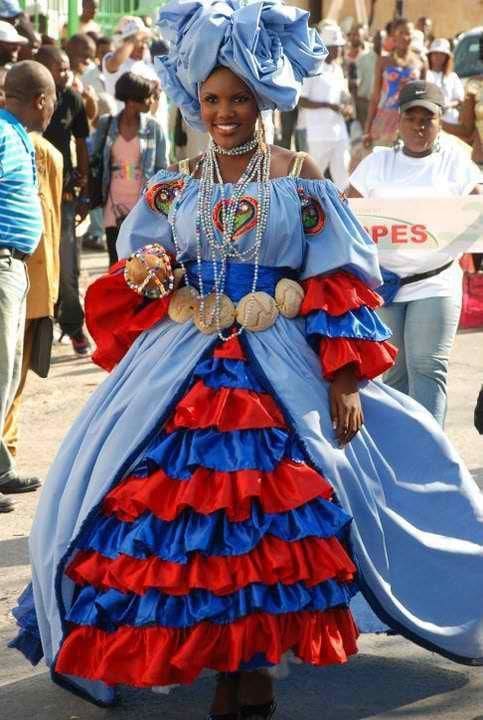Many countries have an authentic and signature style of dress that reflects their culture, and the nation of Haiti is no exception.
The Quadrille or Karabela Dress
The traditional dress of the women of Haiti is known as the Quadrille or Karabela dress. This dress is almost always made of an off-the-shoulder top or bodice with a full, matching skirt. Haitians favor using fabrics in various shades of reds and blue as is traditional for their culture. Despite the warm climate of the islands, the Quadrille is generally made from sturdier fabrics and is often embellished with additional ruffles, lace, or ric rac to add color and visual interest.

Headwear
women in Haiti often wear headscarves or turbans for both dress and everyday life, especially in rural areas. This is a part of the traditional dress of the island and you may find that the more elaborate the dress, the fancier and more layered the headwrap.

Men’s Traditional Dress
In cultural dances and for show, Haitian men will often wear a jacket and pants that correspond with their female dancing partners. Haitian dress shirts are known as a guayabera, or “wedding shirt,” and are often constructed from lightweight fabrics such as linen or cotton. These shirts are often made with two closely-sewn pleats running vertically up each side of the shirt, which is typically worn untucked.

The textiles used for traditional Haitian dresses are often madras checks. Madras is a natural cotton fabric that resembles scottish plaids. The colours are always warm, rich and vibrant. It is worn as a wide skirt or tied on the hips as a bandana. The fabric is breathable and lightweight, making it perfect for the hot and humid Haitian climate.
PAINTINGS
Haitian paintings are generally divided into two categories: naives and moderns. This division has been widely accepted in Haitian arts. The naive painters are known as primitives, and it’s been said that their style lacks artistic education and discipline. The modern painters have come to view the term “naif” as a negative connotation on the evolution of Haitian paintings. However, the term naive has more to do with independence from academic tradition, and it is a style that suggested artistic innocence. When in 1978 more than one-hundred works of Haitian art were put on exhibition at the Brooklyn Museum and collectors were quick to note the exhibition had focused too much on untrained artists and “their traditional depictions of simple village and market scenes, rendered in vivid colors. They argued that by omitting more experimental pieces, the show fostered a stereotype of Haitian art as primitive and naive”. This division has not subsided, despite some changes, such as moving beyond the traditional colors and themes.

SEQUIN FLAGS
Doubtless the most spectacular Haitian art form is the sequin-covered banners derive directly from a syncretism of traditional African religions brought to Haiti by slaves, with the Catholicism of their former masters. The banners are traditionally the work of practicing priests and their followers. They are displayed in sanctuaries and are carried at the commencement of a ceremony. Each flag depicts the symbol or image of the spirit to which it is devoted. The flags are made of shiny silk fabrics to which have been sewn a brilliant mosaic of sequins and beads. A full-size banner typically contains 18,000 to 20,000 sequins and may take ten days to complete. While these flags are religious icons they are also beautiful collectables.

METAL SCULPTURES
The art of Haiti is known worldwide and one of the most unique forms of art is the Haitian steel drum art. Metal drums, once used for transporting oil or other products are purchased near the port in the capitol city of Port au Prince. They are brought to the neighboring town of Croix-des-Bouquets by hand cart or on top of a taxi to the metal artists’ workshop. Croix-des-Bouquets is the center of the Haitian metalwork movement. When driving through the primitive streets, one hears the sounds coming from the homes of various artists as they pound on the drums, expressing their art. As in any art form, some metal work is far superior to others. We have committed ourselves to seeking out the very best metal artists.

CRAFTS
Haitians have been making crafts for years. Some religious icons and prayer vessels made with bottles and sequins. Small sculptures and boxes. Ornate wooden furniture, hand carved and painted are popular crafts. Leather sculptures and jewelry are popular choices for tourists. In the winter, children create hand made paper houses that are decorated with candles. Hand sewn clothing and jackets are made by seamstresses across the country. One of the most unifying elements in all Haitian art is the bright color and playful imagery.


